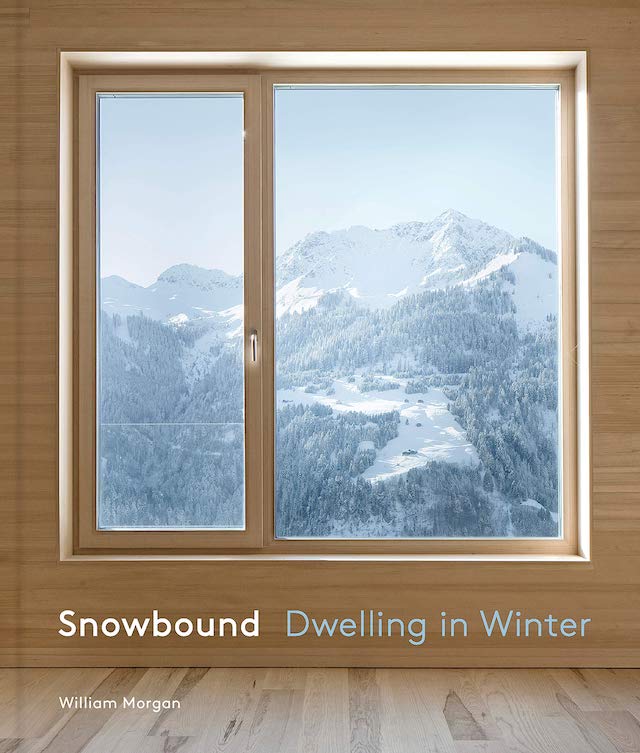Snowbound
Snowbound: Dwelling in Winter William MorganPrinceton Architectural Press, October 2020Hardcover | 8 x 10 inches | 224 pages | 100 illustrations | English | ISBN: 978-1616898670 | $50.00PUBLISHER'S DESCRIPTION: From the ski slopes of Utah to the frigid tundra of northwestern Russia, Snowbound celebrates contemporary design in cold climates with a focus on sustainability. Tailor-made for architects, designers, snowbirds, and aspiring second-home owners, this tour of twenty dwellings is equal parts escapist photo essay and practical sourcebook, with immersive photography, architectural plans, and location, climate, and building-systems data. Architectural historian William Morgan documents winter dwellings and trekker cabins from high-profile firms like MacKay-Lyons Sweetapple and rising stars like Scott & Scott. Readers are transported to beautiful, pristine, and, in some cases, remote locations in the snowier regions of the world. William Morgan is a Providence RI-based architectural writer. He has taught about cities and their history at Princeton, the University of Louisville, and Roger Williams University. He is the author of Louisville: Architecture and the Urban Environment. REFERRAL LINKS: dDAB COMMENTARY: When I think of snow and buildings, two Alps I've been to come to mind: those in Switzerland and those in Japan. The latter is home to the Mountain Pavilion in Bambajima, which British architect Peter Salter designed, in part, to provide spaces for animals to dwell during the winter months; it also features an elaborate system of pipes to slow the trickle of water after the snow melts in the spring. Although I didn't experience the building nor the Japanese Alps in the snowy months, I was able to visit Muzeum Susch, St. Moritz, and other parts of Switzerland in February 2019, when I noticed snow-covered buildings of all sorts and realized how the snow creates a thermal blanket that aids in keeping the interiors relatively warm. Cleary, designing buildings for cold places requires taking into account snow, even if the reliable patterns of snowy weather is changing due to climate change. Snowbound collects 20 recently completed residential projects across four continents: 20 examples of "design that is based on respect for a harsh climate," in author William Morgan's words. Although he acknowledges the projects "are still the result of aesthetic decisions," they share some traits that arise from confronting cold climates, many counter to business-as-usual residential design. These range from small footprints (though admittedly, some are cabins, not full-blown houses) and local materials to alternative energy sources, heavily insulated exteriors, and touching the earth lightly. The selection of projects is solid in terms of quality and diversity, and accompanying Morgan's descriptive text are stats that drive home the differences between these "snowbound" houses and others: square footage, building materials, energy systems, latitude/longitude, and average winter lows. The last tend to hover just below 0˚C, though a shelter in Russia dips down to a -14˚C (6˚F) average winter low. Snowbound functions as a contemporary collection of dwellings united by climate and the architectural considerations mentioned above. Cold-weather houses aren't really a typology per se, so the practical application of this book is less than its appeal as eye candy, especially on coffee tables located next fireplaces in cozy winter cabins. That said, I must applaud the inclusion of floor plans and other drawings for each house, an element missing from too many architecture books these days. Nevertheless, the book made me think about the suitability of certain subjects as books or as online content. Would this have been better as a curated collection of projects on a website? Most, if not all, of the projects are online on various platforms already, so it's certainly feasible. But pulling them together into one bound book, with floor plans drawn consistently (something that also happens in magazines, not websites), does something websites can't do: it creates a mood and helps readers focus on things they might not otherwise see on the computer screen. SPREADS:

Princeton Architectural Press, October 2020
Hardcover | 8 x 10 inches | 224 pages | 100 illustrations | English | ISBN: 978-1616898670 | $50.00
PUBLISHER'S DESCRIPTION:
REFERRAL LINKS:
SPREADS:










